Mybatis
参考资料
尚硅谷Mybatis2022版教程
1.什么是Mybatis
1.1Mybatis的特性
1) MyBatis 是支持定制化 SQL、存储过程以及高级映射的优秀的持久层框架
2) MyBatis 避免了几乎所有的 JDBC 代码和手动设置参数以及获取结果集
3) MyBatis可以使用简单的XML或注解用于配置和原始映射,将接口和Java的POJO(Plain Old Java
Objects,普通的Java对象)映射成数据库中的记录
4) MyBatis 是一个 半自动的ORM(对象关系映射)框架
5)轻量级,性能出色
6)SQL 和 Java 编码分开,功能边界清晰。Java代码专注业务、SQL语句专注数据
7)开发效率稍逊于HIbernate,但是完全能够接受
1.2Mybatis的下载
下载地址:
mybatis下载
点开链接后往下拉
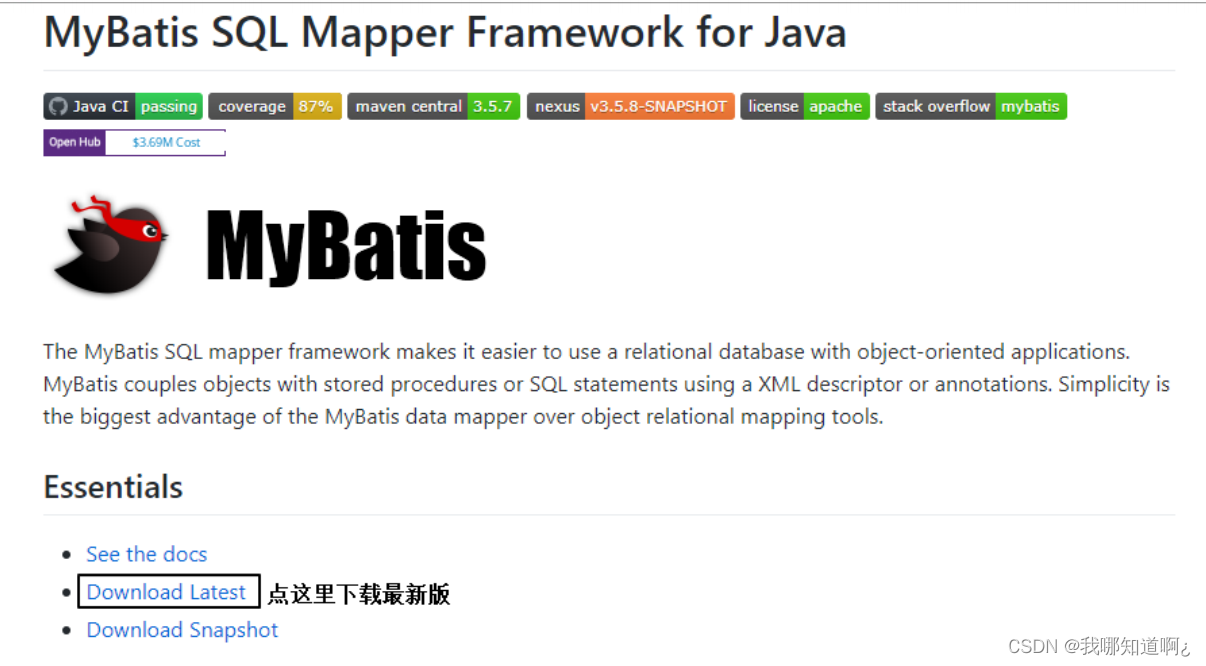
选择第一个下载
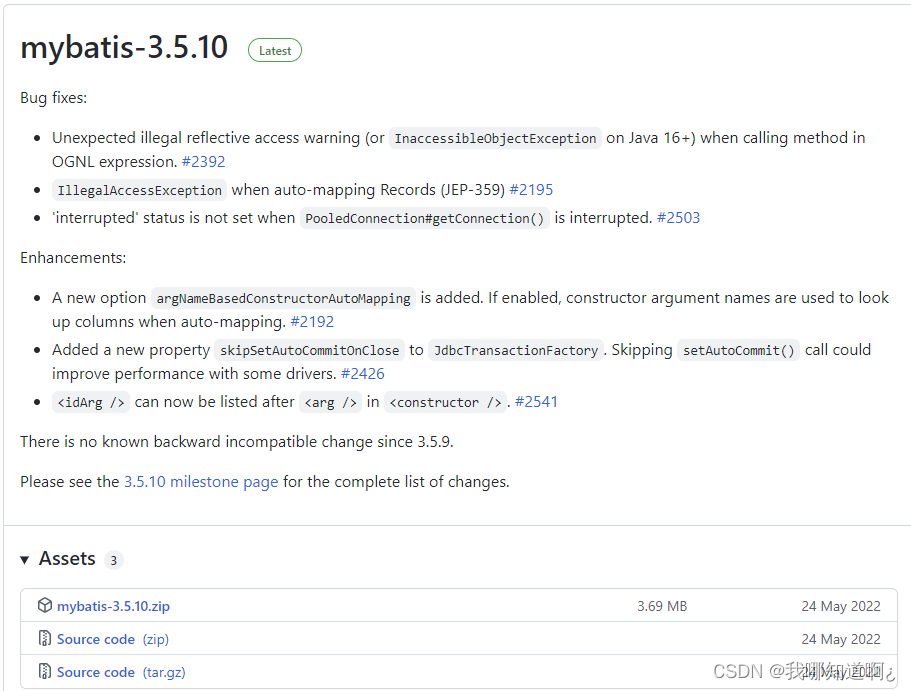
下载后解压即可,里面的pdf是官方文档,建议收藏,jar包可以通过maven下载,所以用不到。

2.搭建Mybatis
2.1创建maven工程
新建一个空的project,在Settings中找到maven,修改idea自带的maven为你的本地maven
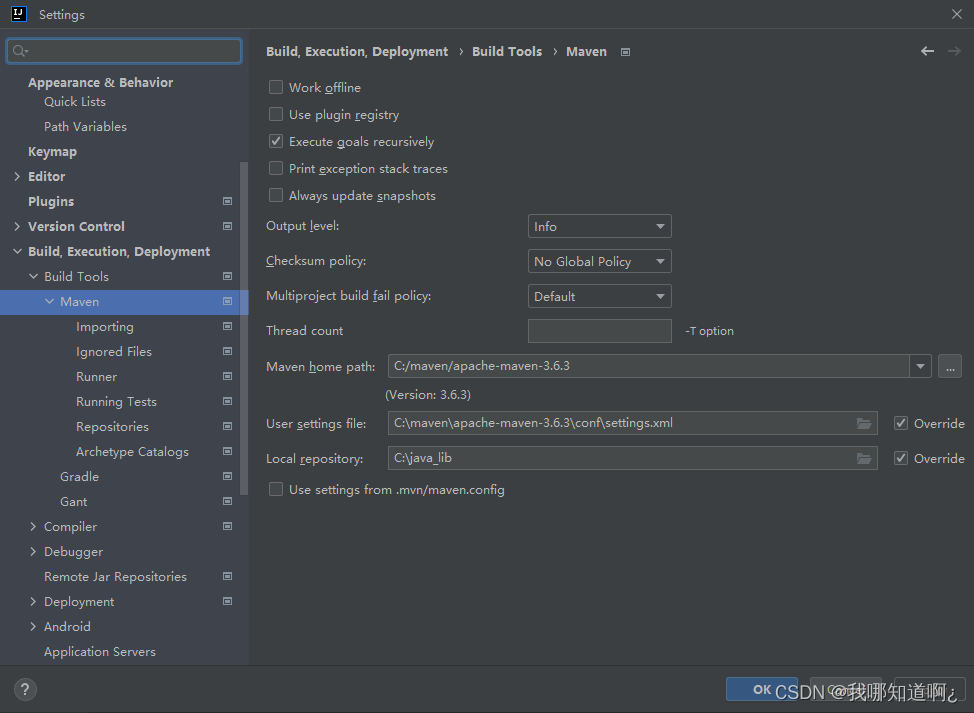
a>打包方式:jar
b>引入依赖
<dependencies>
<!-- Mybatis核心 -->
<dependency>
<groupId>org.mybatis</groupId>
<artifactId>mybatis</artifactId>
<version>3.5.7</version> </dependency>
<!-- junit测试 -->
<dependency>
<groupId>junit</groupId>
<artifactId>junit</artifactId>
<version>4.12</version>
<scope>test</scope> </dependency>
<!-- MySQL驱动 -->
<dependency>
<groupId>mysql</groupId>
<artifactId>mysql-connector-java</artifactId>
<version>5.1.3</version>
</dependency>
</dependencies>
2.2创建mybatis的核心配置文件
习惯上命名为mybatis-config.xml,这个文件名仅仅只是建议,并非强制要求。将来整合Spring之后,这个配置文件可以省略,所以大家操作时可以直接复制、粘贴。
核心配置文件主要用于配置连接数据库的环境以及MyBatis的全局配置信息 核心配置文件存放的位置是src/main/resources目录下
a)官方文档中配置信息的位置

<?xml version="1.0" encoding="UTF-8" ?>
<!DOCTYPE configuration
PUBLIC "-//mybatis.org//DTD Config 3.0//EN"
"http://mybatis.org/dtd/mybatis-3-config.dtd">
<configuration>
<!--配置连接数据库的环境-->
<environments default="development">
<environment id="development">
<!--事务的管理方式-->
<transactionManager type="JDBC"/>
<!--连接数据库的信息-->
<dataSource type="POOLED">
<property name="driver" value="com.mysql.jdbc.Driver"/>
<property name="url" value="jdbc:mysql://localhost:3306/mybatis?characterEncoding=utf8"/>
<property name="username" value="root"/>
<property name="password" value=""/>
</dataSource>
</environment>
</environments>
<!--引入映射文件-->
<mappers>
<mapper resource="mappers/UserMapper.xml"/>
</mappers>
</configuration>
2.3创建Mapper接口
MyBatis中的mapper接口相当于以前的dao。但是区别在于,mapper仅仅是接口,我们不需要提供实现类。
a)在数据库中创建一张表

b)创建对应的实体类*
public class User {
private Integer id;
private String username;
private String password;
private Integer age;
private String sex;
private String email;
}
c)创建Mapper接口(即原来的Dao)
public interface UserMapper {
}
2.4创建Mybatis的映射文件
相关概念:ORM(Object Relationship Mapping)对象关系映射。
对象:Java的实体类对象
关系:关系型数据库
映射:二者之间的对应关系

1、映射文件的命名规则:
表所对应的实体类的类名+Mapper.xml
例如:表t_user,映射的实体类为User,所对应的映射文件为UserMapper.xml
因此一个映射文件对应一个实体类,对应一张表的操作
MyBatis映射文件用于编写SQL,访问以及操作表中的数据
MyBatis映射文件存放的位置是src/main/resources/mappers目录下
2、MyBatis中可以面向接口操作数据,要保证两个一致:
a>mapper接口的全类名和映射文件的命名空间(namespace)保持一致
b>mapper接口中方法的方法名和映射文件中编写SQL的标签的id属性保持一致
下面假设有一个UserMapper(即UserDao),中有一个添加的方法,方法名为:insertUser
那么我们的映射文件(UserMapper.xml)中的对应关系为
<?xml version="1.0" encoding="UTF-8" ?>
<!DOCTYPE mapper
PUBLIC "-//mybatis.org//DTD Mapper 3.0//EN"
"http://mybatis.org/dtd/mybatis-3-mapper.dtd">
<!--mapper接口的全类名和映射文件的命名空间(namespace)保持一致-->
<mapper namespace="mapper.UserMapper">
<!---->
<insert id="insertUser">
insert into t_user values (null,'admin','123456',23,'男','12345@qq.com')
</insert>
</mapper>
在mybatis配置文件中引入映射文件
<mapper resource="mappers/UserMapper.xml"/>
2.5测试功能CRUD
a)添加功能
在上文,我们已经简历好了映射关系,接下来我们来测试添加功能
public class Test {
@org.junit.Test
public void testMybatis() throws IOException {
//加载核心配置文件
InputStream is = Resources.getResourceAsStream("mybatis-config.xml");
//获取SqlSessionFactoryBuilder对象
SqlSessionFactoryBuilder sqlSessionFactoryBuilder = new SqlSessionFactoryBuilder();
//获取SqlSessionFactory
SqlSessionFactory sqlSessionFactory = sqlSessionFactoryBuilder.build(is);
//获取mybatis操作数据库的会话对象
SqlSession sqlSession = sqlSessionFactory.openSession();
//获取Mapper接口的实现类对象,这个方法底层用了代理模式,可以返回一个接口的实现类对象
UserMapper mapper = sqlSession.getMapper(UserMapper.class);
//测试功能
int result = mapper.insertUser();
System.out.println(result);
//提交事务
sqlSession.commit();
}
}
SqlSession:代表Java程序和数据库之间的会话。(HttpSession是Java程序和浏览器之间的会话)
SqlSessionFactory:是“生产”SqlSession的“工厂”。
工厂模式:如果创建某一个对象,使用的过程基本固定,那么我们就可以把创建这个对象的相关代码封装到一个“工厂类”中,以后都使用这个工厂类来“生产”我们需要的对象。
我们也可以优化上面的代码,改为自动提交:
只需要修改一处,加上一个参数true
SqlSession sqlSession = sqlSessionFactory.openSession(true);
b)加入log4j日志功能
加入依赖
<!-- log4j日志 -->
<dependency>
<groupId>log4j</groupId>
<artifactId>log4j</artifactId>
<version>1.2.17</version>
</dependency>
加入log4j的配置文件
log4j的配置文件名为log4j.xml,存放的位置是src/main/resources目录下
<?xml version="1.0" encoding="UTF-8" ?>
<!DOCTYPE log4j:configuration SYSTEM "log4j.dtd">
<log4j:configuration xmlns:log4j="http://jakarta.apache.org/log4j/">
<appender name="STDOUT" class="org.apache.log4j.ConsoleAppender">
<param name="Encoding" value="UTF-8" />
<layout class="org.apache.log4j.PatternLayout">
<param name="ConversionPattern" value="%-5p %d{MM-dd HH:mm:ss,SSS} %m (%F:%L) \n" />
</layout>
</appender>
<!--日志范围-->
<logger name="java.sql">
<!--日志级别-->
<!--FATAL(致命)>ERROR(错误)>WARN(警告)>INFO(信息)>DEBUG(调试) 从左到右打印的内容越来越详细-->
<level value="debug" />
</logger>
<logger name="org.apache.ibatis">
<level value="info" />
</logger>
<root>
<level value="debug" />
<appender-ref ref="STDOUT" />
</root>
</log4j:configuration>
下面是添加功能输出的日志信息

c)修改和删除功能
流程:先写Mapper接口中的方法,再去映射文件中写sql语句
接口对象中的
/**
* 修改用户信息
*/
void updateUser();
/**
*删除用户信息
*/
void deleteUser();
映射文件UserMapper.xml中的
<!--void updateUser();-->
<update id="updateUser">
update t_user set username='张三' where id=3
</update>
<!--void deleteUser();-->
<delete id="deleteUser">
delete from t_user where id=5
</delete>
d)查询功能
接口对象中的
/**
* 根据id查询一条用户信息
*/
User getUserById();
/**
* 查询所有用户信息
*/
List<User> getAllUser();
映射文件UserMapper.xml中的
<!--User getUserById();-->
<!--注意,查询时,我们需要设置结果类型,即要转换成的实体类对象-->
<!--所以查询必须要设置resultType或resultMap-->
<!--
resultType:设置默认的映射关系(自动通过字段名为属性名赋值)
resultMap:设置自定义映射(字段名和属性名不一样时,需要用这个)
-->
<select id="getUserById" resultType="pojo.User">
select * from t_user where id=3
</select>
<!--List<User> getAllUser();-->
<select id="getAllUser" resultType="pojo.User">
select * from t_user;
</select>
3.详解核心配置文件(了解)
核心配置文件中的标签必须按照固定的顺序:
properties?,settings?,typeAliases?,typeHandlers?,
objectFactory?,objectWrapperFactory?,reflectorFactory?,
?,environments?,databaseIdProvider?,mappers?
a)environment
environments:配置多个连接数据库的环境
属性:
default:设置默认使用的环境的id
environment(在environments中):配置某个具体的环境
属性:
id:表示连接数据库的环境的唯一标识,不能重复
transactionManager:事务管理方式,type有JDBC(表示当前环境中,执行SQL时,使用的是jdbc中原生的事务管理方式),MANAGED(被管理,例如spring)
dataSource:配置数据源,type有POOLED(表示使用数据库连接池缓存数据库连接),UNPOLLED(表示不使用数据库连接池),JNDI(表示使用上下文中的数据源)
b)properties
properties配置文件,是以键值对的形式存储数据的,为了properties文件内容重复,我们可以在键值对前加上一个前缀来区分功能。
在mybatis核心配置文件中引入properties文件
<properties resource="jdbc.properties"/>
通过该文件中的键值对来配置数据库
<property name="driver" value="${jdbc.driver}"/>
<!--连接地址-->
<property name="url" value="${jdbc.name}"/>
<!--用户名密码-->
<property name="username" value="${jdbc.username}"/>
<property name="password" value="${jdbc.password}"/>
c)typeAliases
类型别名,根据类型顺序,应该放在properties之后,注意别名不区分大小写
<!--设置类型别名(不区分大小写)-->
<typeAliases>
<!--type为需要设置别名的全类目-->
<!--设置后在查询时,我们就可以直接写User,alias可以不写,如果不写,默认类目-->
<typeAlias type="pojo.User" alias="User"></typeAlias>
</typeAliases>
另一种更简洁的方式
<!--设置别名2-->
<!--以包为单位,将报下的所有类型设置默认的别名,即类名,且类目不区分大小写-->
<typeAliases>
<package name="pojo"/>
</typeAliases>
d)mappers
此标签用于引入映射文件
在前面的CRUD中已经介绍了单独引入映射文件的方法
下面介绍一种以包为单位的引入方法,引入mapper包下的所有映射文件
<mappers>
<!--<mapper resource="mapper/UserMapper.xml"/>-->
<!--
以包为单位引入映射文件
要求:
1.mapper接口所在的包要和映射文件所在的包的名称一致
2.mapper接口要和映射文件的名字一致
-->
<package name="mapper"/>
</mappers>
4.在idea中设置核心配置文件和映射文件的模板
我们可以自己设置一个文件模板,以防止重复劳动
核心配置文件
点击settiings,找到如图选项,点击加号
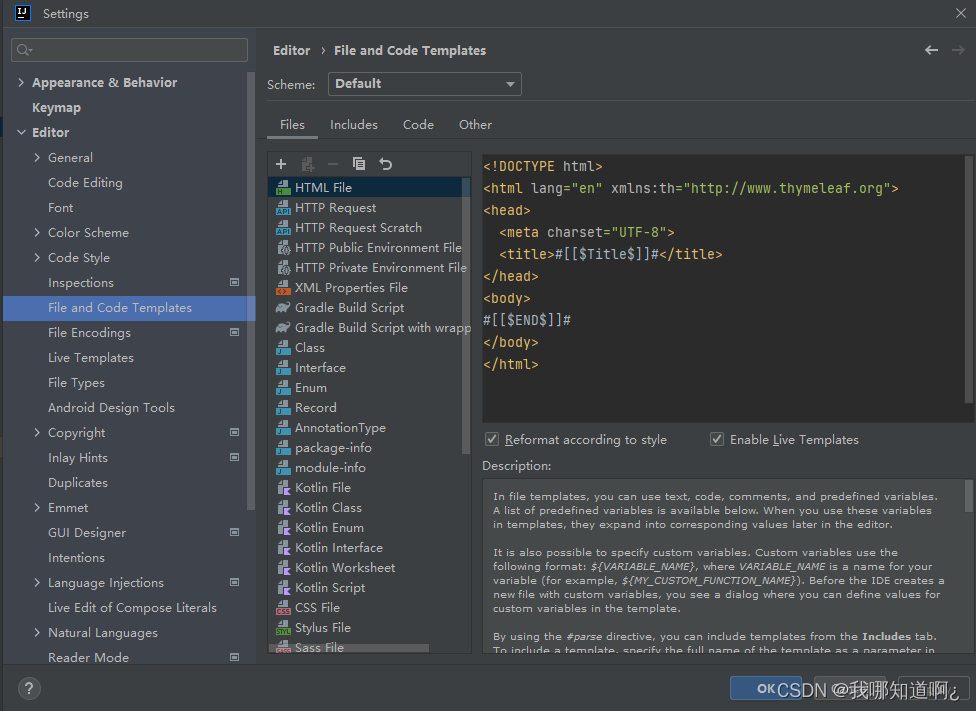
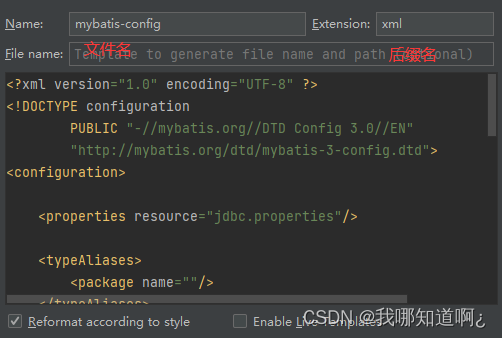
随后,右键new就可以创建一个我们配制好的文件的模板
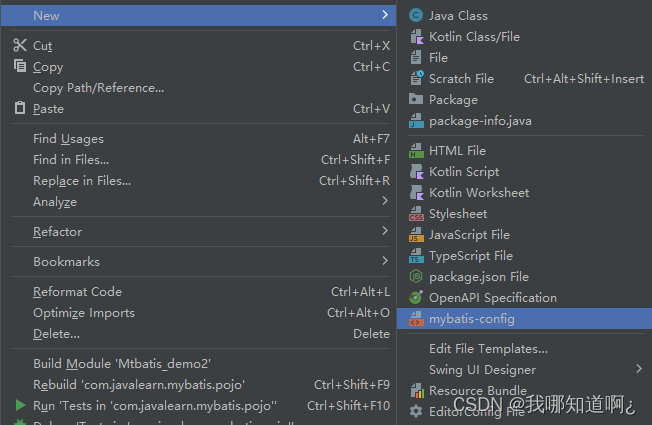
映射文件
和配置文件一样的流程,这里就不再多介绍了
5.Mybatis获取参数值的两种方式(${}和#{})

5.1单个字面量类型的参数
若mapper接口中的方法参数为单个的字面量类型
此时可以使用${}和#{}以任意的名称获取参数的值,注意${}需要手动加单引号
<!--User GetUserByUsername(String username)-->
<select id="GetUserByUsername" resultType="User">
<!--用#{}-->
select * from t_user where username = #{username}
<!--用${}-->
select * from t_user where username = '${username}'
</select>
5.2多个字面量类型的参数
若mapper接口中的方法参数为多个时
此时MyBatis会自动将这些参数放在一个map集合中,以arg0,arg1…为键,以参数为值;或以param1,param2…为键,以参数为值;因此只需要通过${}和#{}访问map集合的键就可以获取相对应的值,注意${}需要手动加单引号
<!--User checkLogin(String username,String password)-->
<select id="checkLogin" resultType="User">
<!--用#{}-->
select * from t_user where username=#{arg0} and password=#{arg1}
<!--用${}-->
select * from t_user where username='${arg0}' and password='${arg1}'
</select>
5.3map集合类型的参数
若mapper接口中的方法需要的参数为多个时,此时可以手动创建map集合,将这些数据放在map中只需要通过${}和#{}访问map集合的键就可以获取相对应的值,注意${}需要手动加单引号,写法与5.2类似,只不过键值对变成了我们自己定义的。
5.4实体类类型的参数(掌握)
若mapper接口中的方法参数为实体类对象时此时可以使用${}和#{},通过访问实体类对象中的属性名获取属性值,注意${}需要手动加单引号,这里底部是用set和get方法实现的。
<!--int insertUser(User user)-->
<insert id="insertUser">
insert into t_user values (null,#{username},#{password},#{age},#{sex},#{email})
</insert>
5.5使用@Param标识参数(掌握)
可以通过@Param注解标识mapper接口中的方法参数
此时,会将这些参数放在map集合中,以@Param注解的value属性值为键,以参数为值;或以param1,param2…为键,以参数为值;只需要通过${}和#{}访问map集合的键就可以获取相对应的值,注意${}需要手动加单引号
其实就是使用mybatis自定义map集合中的键,且5.1,5,2,5.3都可以用此方法代替
mapper接口中的代码
/**
* 验证登录,使用@Param
*/
User checkLoginByParam(@Param("username") String username, @Param("password") String password);
映射文件中的sql语句
<!--User checkLoginByParam(@Param("username") String username, @Param("password") String password)-->
<select id="checkLoginByParam" resultType="User">
select * from t_user where username = #{username} and password = #{password}
</select>
6.Mybatis的各种查询功能
6.1查询一个实体类对象
若查询出的数据,只有一条,可以用实体类对象或集合接受,但若有多条,不能用实体类对象接受,不然会报异常TooManyResultsException
<!--User getUserById(Integer id)-->
<select id="getUserById" resultType="User">
select * from t_user where id = #{id}
</select>
6.2查询一个list集合
若查询出的数据有多条,可以用list接受,一定不能用实体类接受
<!--List<User> getAllUser()-->
<select id="getAllUser" resultType="User">
select * from t_user
</select>
6.3查询单个数据
Mybatis中一共了一些基本数据类型的别名
详情见帮助文档
<!--Integer getCount(),返回值是数值类型-->
<select id="getCount" resultType="java.lang.Integer">
select count(*) from t_user
</select>
6.4查询一条数据为map集合
<!--Map<String,Object> getUserByIdToMap(@Param("id") Integer id),map是mybatis给我们提供的Map的别名,查询结果以字段名为键,字段的值为值-->
<select id="getUserByIdToMap" resultType="map">
select * from t_user where id=#{id}
</select>
输出结果实例:

6.5查询多条数据为map集合
<!--Map<String,Object> getAllUserToMap()-->
<select id="getAllUserToMap" resultType="map">
select * from t_user
</select>
注意,此时每一条数据都会变成一个类似于6.4中的map集合,所以我们方法的返回值不能为Map
a)用List实体类进行接收
List<Map<String,Object>> getAllUserToMap();
b)在mapper接口的方法上,使用MapKey注解
@MapKey("id")//把查询出来的某个字段作为键,把对应的map作为值,这里就是以id作为键,放在同一个map集合中,注意,字段需要唯一
Map<String,Object> getAllUserToMap();
7.特殊SQL的执行
7.1模糊查询
<!--List<User> getUserByLike(@Param("username") String username)-->
<select id="getUserByLike" resultType="User">
<!--写法一,使用${}-->
select * from t_user where username like '%${username}%'
<!--写法二,使用SQL的字符串拼接函数-->
select * from t_user where username like concat('%',#{username},'%')
<!--写法三-->
select * from t_user where username like "%"#{username}"%"
</select>
7.2批量删除
<!--int deleteMore(@Param("ids") String ids)-->
<delete id="deleteMore">
<!--不能使用#{},应为会自动加单引号,这样的sql语句是不正确的,不为字符串的不能加''-->
delete from t_user where id in (${ids})
</delete>
7.3动态设置表名
<!--List<User> getUserByTableName(@Param("tableName") String tableName)-->
<select id="getUserByTableName" resultType="User">
<!--只能用${},因为表名不能加''-->
select * from ${tableName}
</select>
7.4添加功能获取自增的主键
t_clazz(clazz_id,clazz_name)
t_student(student_id,student_name,clazz_id)
1、添加班级信息
2、获取新添加的班级的id
3、为班级分配学生,即将某学的班级id修改为新添加的班级的id
<!--void insertUser(User user),获取自动递增的主键需要设置两个属性useGeneratedKeys(sql使用了自动递增的主键) keyProperty(将自动递增的主键赋值给参数中的某个属性中)-->
<insert id="insertUser" useGeneratedKeys="true" keyProperty="id">
insert into t_user values (null,#{username},#{password},#{age},#{sex},#{email})
</insert>
测试代码
User user = new User(null,"王五","123",23,"男","1234@qq.com");
sqlMapper.insertUser(user);
//此时自动递增的主键已经被放在了id属性中
System.out.println(user.getId());
8.自定义映射resultMap
若字段名和实体类中的属性名不一致,则可以通过resultMap设置自定义映射
8.1resultMap处理字段和属性的映射关系
a)通过字段名别名
<!--List<Emp> getAllEmp()-->
<select id="getAllEmp" resultType="Emp">
<!--若不设置别名,字段名与属性不一致幅查询结果会为null-->
select eid,emp_name empName,age,sex,email from t_emp
</select>
b)通过全局配置mapUnderscoreToCamelCase
在mybatis中的配置文件加入
<!--设置mybatis的全局配置-->
<settings>
<!--将表中的下划线字段名自动映射为驼峰,emp_name->empName-->
<setting name="mapUnderscoreToCamelCase" value="true"/>
</settings>
c)resultMap
<!--设置自定义映射关系-->
<resultMap id="empResultMap" type="Emp">
<!--id设置主键的映射关系(唯一标识),type设置映射关系中的实体类类型-->
<!--property:属性名(必须是type设置的实体类的属性名)column:字段名(必须是sql语句查询出的字段名)-->
<id property="eid" column="eid"></id>
<!--result设置普通字段的映射关系-->
<result property="empName" column="emp_name"></result>
<result property="age" column="age"></result>
<result property="sex" column="sex"></result>
<result property="email" column="email"></result>
</resultMap>
<!--List<Emp> getAllEmp()-->
<select id="getAllEmp" resultMap="empResultMap">
select * from t_emp
</select>
d)通过级联属性赋值解决多对一的映射关系(第一种方式)
假设有两个类,emp与dept,一个emp对应一个dept,一个dept对应多个emp
emp中:
private Dept dept;
现在假设有一个方法getEmpAndDept,我们希望查询出一个emp对应的dept信息
<!--处理多对一映射方式一:级联赋值-->
<resultMap id="empAndDeptResultMapOne" type="Emp">
<id property="eid" column="eid"></id>
<result property="empName" column="emp_name"></result>
<result property="age" column="age"></result>
<result property="sex" column="sex"></result>
<result property="email" column="email"></result>
<!--级联赋值给emp中的dept属性赋值-->
<result property="dept.did" column="did"></result>
<result property="dept.deptName" column="dept_name"></result>
</resultMap>
<!--Emp getEmpAndDept(@Param("eid") Integer eid)-->
<select id="getEmpAndDept" resultMap="empAndDeptResultMapOne">
select * from t_emp left join t_dept on t_emp.did = t_dept.did where t_emp.eid=#{eid}
</select>
d)通过association解决多对一的映射关系(第二种方式)
<!--处理多对一映射方式二:association-->
<resultMap id="empAndDeptResultMapTwo" type="Emp">
<id property="eid" column="eid"></id>
<result property="empName" column="emp_name"></result>
<result property="age" column="age"></result>
<result property="sex" column="sex"></result>
<result property="email" column="email"></result>
<!--
association:处理多对一的关系,相当于一个外部bean注入
property:需要被处理多对一映射关系的属性名
javaType:该属性类型的实体类
-->
<association property="dept" javaType="Dept">
<id property="did" column="did"></id>
<result property="deptName" column="dept_name"></result>
</association>
</resultMap>
<!--Emp getEmpAndDept(@Param("eid") Integer eid)-->
<select id="getEmpAndDept" resultMap="empAndDeptResultMapTwo">
select * from t_emp left join t_dept on t_emp.did = t_dept.did where t_emp.eid=#{eid}
</select>
e)通过分步查询解决多对一的映射关系(第三种方式,重点掌握)
<!--
assoication中:
select:设置分步查询的sql的唯一标识
column:设置分步查询的查询条件
-->
<!--先查出eid对应的员工信息,再通过did查询其所对应的部门-->
<resultMap id="empAndDeptByStepResultMap" type="Emp">
<id property="eid" column="eid"></id>
<result property="empName" column="emp_name"></result>
<result property="age" column="age"></result>
<result property="sex" column="sex"></result>
<result property="email" column="email"></result>
<association property="dept"
select="com.javalearn.mybatis.mapper.DeptMapper.getEmpAndDeptByStepTwo"
column="did">
</association>
</resultMap>
<!--Emp getEmpAndDeptByStepOne(@Param("eid") Integer eid)-->
<select id="getEmpAndDeptByStepOne" resultMap="empAndDeptByStepResultMap">
select * from t_emp where eid = #{eid}
</select>
第二条sql语句:
<!--Dept getEmpAndDeptByStepTwo(@Param("did") Integer did)-->
<select id="getEmpAndDeptByStepTwo" resultType="Dept">
select * from t_dept where did=#{did}
</select>
分步查询的优点:可以实现延迟加载,但是必须在核心配置文件中设置全局配置信息:
lazyLoadingEnabled:延迟加载的全局开关。当开启时,所有关联对象都会延迟加载(只访问员工就只查询员工,不会再执行第二步的查询部门信息),在settings标签下
aggressiveLazyLoading:当开启时,任何方法的调用都会加载该对象的所有属性。 否则,每个 属性会按需加载
此时就可以实现按需加载,获取的数据是什么,就只会执行相应的sql。此时可通过association和collection中的fetchType属性设置当前的分步查询是否使用延迟加载,fetchType="lazy(延迟加载)|eager(立即加载)
延迟加载的效果如下

f)通过collection解决一对多映射关系
一个部门dept,对应多个员工emp,dept中如下
private List<Emp> emps;
查询一个部门和其所有员工的信息:
<!--处理一对多的第一种方式-->
<resultMap id="DeptAndEmpResultMap" type="Dept">
<id property="did" column="did"></id>
<result property="deptName" column="dept_name"></result>
<!--
collection:处理一对多的映射关系
ofType:表示该属性所对应集合中存储数据的类型
-->
<collection property="emps" ofType="Emp">
<id property="eid" column="eid"></id>
<result property="empName" column="emp_name"></result>
<result property="age" column="age"></result>
<result property="sex" column="sex"></result>
<result property="email" column="email"></result>
</collection>
</resultMap>
<!--Dept getDeptAndEmp(@Param("did") Integer did)-->
<select id="getDeptAndEmp" resultMap="DeptAndEmpResultMap">
select * from t_dept left join t_emp on t_dept.did = t_emp.did where t_dept.did=#{did}
</select>
f)通过分步查询解决一对多映射关系
也是一样的,我们先查询部门信息,在根据did查询员工信息
第一步查部门
<resultMap id="deptAndEmpByStepResultMap" type="Dept">
<id property="did" column="did"></id>
<result property="deptName" column="dept_name"></result>
<collection property="emps"
select="com.javalearn.mybatis.mapper.EmpMapper.getDeptAndEmpByStepTwo"
column="did"></collection>
</resultMap>
<!--Dept getDeptAndEmpByStepOne(@Param("did") Integer did)-->
<select id="getDeptAndEmpByStepOne" resultMap="deptAndEmpByStepResultMap">
select * from t_dept where did = #{did}
</select>
第二步查员工
<!--List<Emp> getDeptAndEmpByStepTwo(@Param("did") Integer did)-->
<select id="getDeptAndEmpByStepTwo" resultType="Emp">
select * from t_emp where did = #{did}
</select>
9.动态SQL
Mybatis框架的动态SQL技术是一种根据特定条件动态拼装SQL语句的功能,它存在的意义是为了解决拼接SQL语句字符串时的痛点问题。(主要是拼接条件或关键字)
9.1if
if标签可通过test属性的表达式进行判断,若表达式的结果为true,则标签中的内容会执行;反之标签中的内容不会执行,1=1是为了SQL语句不出错
<!--List<Emp> getEmpByCondition(Emp emp)-->
<select id="getEmpByCondition" resultType="Emp">
select * from t_emp where 1=1
<if test="empName != null and empName != ''">
and emp_name = #{empName}
</if>
<if test="age != null and age != ''">
and age = #{age}
</if>
<if test="sex != null and sex != ''">
and sex = #{sex}
</if>
<if test="email != null and email != ''">
and email = #{email}
</if>
</select>
假设我们的方法传入参数为:
List<Emp> list = mapper.getEmpByCondition(new Emp(null,null,23,"男","123@qq.com"));
经过拼接的sql语句为

9.2where
where和if一般结合使用:
a>若where标签中的if条件都不满足,则where标签没有任何功能,即不会添加where关键字
b>若where标签中的if条件满足,则where标签会自动添加where关键字,并将条件最前方多余的and去掉
注意:where标签不能去掉条件最后多余的and
<!--List<Emp> getEmpByCondition(Emp emp)-->
<!--方式二:where标签-->
<select id="getEmpByCondition" resultType="Emp">
select * from t_emp
<where>
<if test="empName != null and empName != ''">
emp_name = #{empName}
</if>
<if test="age != null and age != ''">
and age = #{age}
</if>
<if test="sex != null and sex != ''">
and sex = #{sex}
</if>
<if test="email != null and email != ''">
and email = #{email}
</if>
</where>
</select>
9.3trim
trim用于去掉或添加标签中的内容
常用属性:
prefix:在trim标签中的内容的前面添加某些内容
suffix:在trim标签中的内容的后面添加某些内容
prefixOverrides:在trim标签中的内容的前面去掉某些内容
suffixOverrides:在trim标签中的内容的后面去掉某些内容
<!--List<Emp> getEmpByCondition(Emp emp)-->
<!--方式三:trim-->
<select id="getEmpByCondition" resultType="Emp">
select * from t_emp
<!--在前面加上where,去除后面多余的and或者or,所有标签均不成立则trim标签无效-->
<trim prefix="where" suffixOverrides="and|or">
<if test="empName != null and empName != ''">
emp_name = #{empName} and
</if>
<if test="age != null and age != ''">
age = #{age} or
</if>
<if test="sex != null and sex != ''">
sex = #{sex} and
</if>
<if test="email != null and email != ''">
email = #{email}
</if>
</trim>
</select>
9.4choose、when、otherwise
choose、when、otherwise相当于if…else if…else
<!--List<Emp> getEmpByChoose(Emp emp)-->
<select id="getEmpByChoose" resultType="Emp">
select * from t_emp
<!--使用where自动生成where-->
<where>
<!--choose是一个副标签-->
<choose>
<!--有一个when成立后面的when就不会执行了-->
<when test="empName != null and empName !=''">
emp_name = #{empName}
</when>
<when test="age != null and age !=''">
age = #{age}
</when>
<when test="sex != null and sex !=''">
sex = #{sex}
</when>
<when test="empName != null and empName !=''">
email = #{email}
</when>
<!--所有条件都不满足就会执行这个otherwise-->
<otherwise>
did = 1
</otherwise>
</choose>
</where>
</select>
9.5foreach
通过传入数组参数的方式实现批量删除
<!--int deleteMoreByArray(@Param("eids") Integer[] eids),通过数组实现批量删除-->
<delete id="deleteMoreByArray">
delete from t_emp where eid in
<!--collection表示我们要访问的这个数组或集合,item是数组或集合里的每一个数据,separator:数据的分隔符 open:以什么开始 close:以什么结束-->
<foreach collection="eids" item="eid" separator="," open="(" close=")">
#{eid}
</foreach>
</delete>
通过传入集合参数实现批量添加
<!--int insertMoreByList(@Param("emps") List<Emp> emps)-->
<insert id="insertMoreByList">
insert into t_emp values
<foreach collection="emps" item="emp" separator=",">
(null,#{emp.empName},#{emp.age},#{emp.sex},#{emp.email},null)
</foreach>
</insert>
9.6SQL片段
sql片段,可以记录一段公共sql片段,在使用的地方通过include标签进行引入
<!--sql片段-->
<sql id="empColumns">eid,emp_name,age,sex,email</sql>
引入sql片段
select <include refid="empColumns"></include> from t_emp
10.mybatis的缓存
10.1mybatis的一级缓存(SqlSession级别)
一级缓存是SqlSession级别的,通过同一个SqlSession查询的数据会被缓存,下次查询相同的数据,就会从缓存中直接获取,不会从数据库重新访问(一级缓存是默认开启的),mapper不是同一个也没有关系,只要是通过同一个SqlSession获取的就可以。
一个简单的例子:
@Test
public void test9(){
SqlSession sqlSession = SqlSessionUtils.getSqlSession();
CacheMapper mapper = sqlSession.getMapper(CacheMapper.class);
Emp emp = mapper.getEmpByEid(1);
System.out.println(emp);
Emp emp2 = mapper.getEmpByEid(1);
System.out.println(emp2);
}
输出结果
可以看到只执行了一条sql语句,第二条数据是从缓存中查询的

下面是一级缓存失效的四种情况
- 不同的SqlSession对应不同的一级缓存
- 同一个SqlSession但是查询条件不同(查询了不同的数据)
- 同一个SqlSession两次查询期间执行了任何一次增删改操作(数据被改变了,缓存会被清空)
- 同一个SqlSession两次查询期间手动清空了缓存(sqlSession.clearCache();)
10.2mybatis的二级缓存(SqlSessionFactory级别)
二级缓存是SqlSessionFactory级别,通过同一个SqlSessionFactory创建的SqlSession查询的结果会被缓存;此后若再次执行相同的查询语句,结果就会从缓存中获取
二级缓存开启的条件:
a>在核心配置文件中,设置全局配置属性cacheEnabled=“true”,默认为true,不需要设置
b>在映射文件中设置标签<cache />

c>二级缓存必须在SqlSession关闭或提交之后有效(没有关闭或提交时,数据会保存到一级缓存,关闭或提交后会保存到二级缓存)
d>查询的数据所转换的实体类类型必须实现序列化的接口(Serializable)
一个小小的例子:
@Test
public void test10(){
try {
InputStream is = Resources.getResourceAsStream("mybatis-config.xml");
SqlSessionFactory sqlSessionFactory = new SqlSessionFactoryBuilder().build(is);
SqlSession sqlSession1 = sqlSessionFactory.openSession(true);
SqlSession sqlSession2 = sqlSessionFactory.openSession(true);
CacheMapper mapper = sqlSession1.getMapper(CacheMapper.class);
System.out.println(mapper.getEmpByEid(1));
sqlSession1.close();
CacheMapper mapper2 = sqlSession2.getMapper(CacheMapper.class);
System.out.println(mapper2.getEmpByEid(1));
sqlSession2.close();
} catch (IOException e) {
throw new RuntimeException(e);
}
}
输出结果:

使二级缓存失效的情况:
两次查询之间执行了任意的增删改,会使一级和二级缓存同时失效
在mapper配置文件中添加的cache标签可以设置一些属性:
10.3二级缓存的相关设置
在映射文件中的cache标签中设置
1.evtion属性:缓存回收策略
LRU(Least Recently Used) – 最近最少使用的:移除最长时间不被使用的对象。
FIFO(First in First out) – 先进先出:按对象进入缓存的顺序来移除它们。
SOFT – 软引用:移除基于垃圾回收器状态和软引用规则的对象。
WEAK – 弱引用:更积极地移除基于垃圾收集器状态和弱引用规则的对象。
默认的是 LRU。
2.flushInterval属性:刷新间隔,单位毫秒
默认情况是不设置,也就是没有刷新间隔,缓存仅仅调用语句时刷新(增删改)
3.size属性:引用数目,正整数
代表缓存最多可以存储多少个对象,太大容易导致内存溢出
4.readOnly属性:只读,true/false
true:只读缓存;会给所有调用者返回缓存对象的相同实例。因此这些对象不能被修改。这提供了很重要的性能优势。
false:读写缓存;会返回缓存对象的拷贝(通过序列化,对原本的缓存对象不会有影响)。这会慢一些,但是安全,因此默认是false。
10.4mybatis缓存查询的顺序(从大到小)
先查询二级缓存,因为二级缓存中可能会有其他程序已经查出来的数据,可以拿来直接使用。
如果二级缓存没有命中,再查询一级缓存
如果一级缓存也没有命中,则查询数据库
SqlSession关闭之后,一级缓存中的数据会写入二级缓存
10.5整合第三方缓存EHCache(代替二级缓存)
a>添加依赖
<!-- Mybatis EHCache整合包 -->
<dependency>
<groupId>org.mybatis.caches</groupId>
<artifactId>mybatis-ehcache</artifactId>
<version>1.2.1</version>
</dependency>
<!-- slf4j日志门面的一个具体实现 -->
<dependency>
<groupId>ch.qos.logback</groupId>
<artifactId>logback-classic</artifactId>
<version>1.2.3</version>
</dependency>
b>各jar包功能

c>创建EHCache的配置文件ehcache.xml
<?xml version="1.0" encoding="utf-8" ?>
<ehcache xmlns:xsi="http://www.w3.org/2001/XMLSchema-instance"
xsi:noNamespaceSchemaLocation="../config/ehcache.xsd">
<!-- 磁盘保存路径 ,换成自己想保存的路径-->
<diskStore path="D:\atguigu\ehcache"/>
<defaultCache
maxElementsInMemory="1000"
maxElementsOnDisk="10000000"
eternal="false"
overflowToDisk="true"
timeToIdleSeconds="120"
timeToLiveSeconds="120"
diskExpiryThreadIntervalSeconds="120"
memoryStoreEvictionPolicy="LRU">
</defaultCache>
</ehcache>
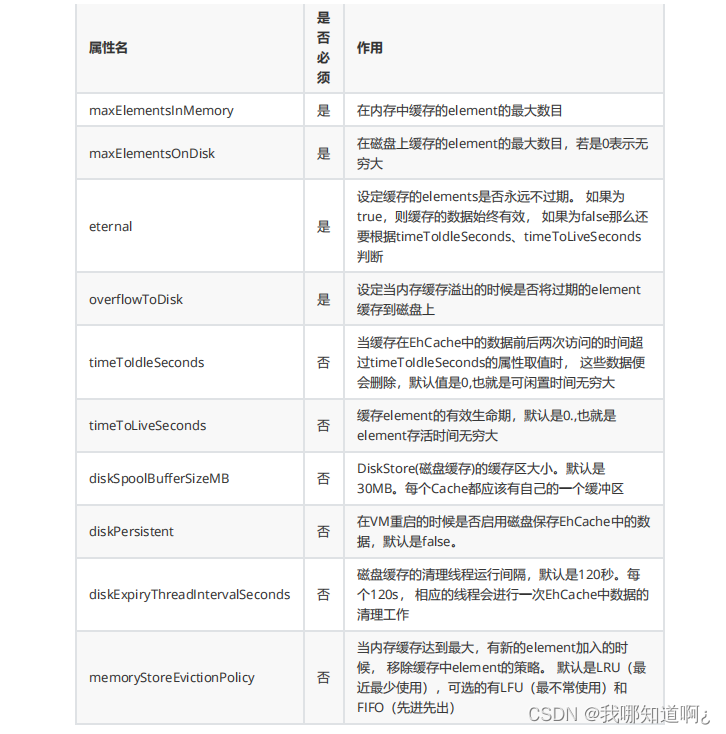
d>设置二级缓存的类型
<cache type="org.mybatis.caches.ehcache.EhcacheCache"/>
e>加入logback日志
存在SLF4J时,作为简易日志的log4j将失效,此时我们需要借助SLF4J的具体实现logback来打印日志。创建logback的配置文件logback.xml
<?xml version="1.0" encoding="UTF-8"?>
<configuration debug="true">
<!-- 指定日志输出的位置 -->
<appender name="STDOUT" class="ch.qos.logback.core.ConsoleAppender">
<encoder>
<!-- 日志输出的格式 -->
<!-- 按照顺序分别是:时间、日志级别、线程名称、打印日志的类、日志主体内容、换行 -->
<pattern>[%d{HH:mm:ss.SSS}] [%-5level] [%thread] [%logger] [%msg]%n</pattern>
</encoder>
</appender>
<!-- 设置全局日志级别。日志级别按顺序分别是:DEBUG、INFO、WARN、ERROR -->
<!-- 指定任何一个日志级别都只打印当前级别和后面级别的日志。 -->
<root level="DEBUG">
<!-- 指定打印日志的appender,这里通过“STDOUT”引用了前面配置的appender -->
<appender-ref ref="STDOUT" />
</root>
<!-- 根据特殊需求指定局部日志级别 ,换成自己的mapper路径-->
<logger name="com.atguigu.crowd.mapper" level="DEBUG"/>
</configuration>
11.mybatis的逆向工程
正向工程:先创建Java实体类,由框架负责根据实体类生成数据库表。Hibernate是支持正向工程的。
逆向工程:先创建数据库表,由框架负责根据数据库表,反向生成如下资源:
Java实体类
Mapper接口
Mapper映射文件
11.1创建逆向工程的步骤
a>添加依赖和插件
<?xml version="1.0" encoding="UTF-8"?>
<project xmlns="http://maven.apache.org/POM/4.0.0"
xmlns:xsi="http://www.w3.org/2001/XMLSchema-instance"
xsi:schemaLocation="http://maven.apache.org/POM/4.0.0 http://maven.apache.org/xsd/maven-4.0.0.xsd">
<modelVersion>4.0.0</modelVersion>
<groupId>com.javalearn.mybatis</groupId>
<artifactId>Mybatis_MBG</artifactId>
<version>1.0-SNAPSHOT</version>
<packaging>jar</packaging>
<properties>
<maven.compiler.source>18</maven.compiler.source>
<maven.compiler.target>18</maven.compiler.target>
</properties>
<!-- 依赖MyBatis核心包 -->
<dependencies>
<dependency>
<groupId>org.mybatis</groupId>
<artifactId>mybatis</artifactId>
<version>3.5.7</version>
</dependency>
</dependencies>
<!-- 控制Maven在构建过程中相关配置 -->
<build>
<!-- 构建过程中用到的插件 -->
<plugins>
<!-- 具体插件,逆向工程的操作是以构建过程中插件形式出现的 -->
<plugin>
<groupId>org.mybatis.generator</groupId>
<artifactId>mybatis-generator-maven-plugin</artifactId>
<version>1.3.0</version>
<!-- 插件的依赖 -->
<dependencies>
<!-- 逆向工程的核心依赖 -->
<dependency>
<groupId>org.mybatis.generator</groupId>
<artifactId>mybatis-generator-core</artifactId>
<version>1.3.2</version>
</dependency>
<!-- 数据库连接池 -->
<dependency>
<groupId>com.mchange</groupId>
<artifactId>c3p0</artifactId>
<version>0.9.2</version>
</dependency>
<!-- MySQL驱动 -->
<dependency>
<groupId>mysql</groupId>
<artifactId>mysql-connector-java</artifactId>
<version>5.1.8</version>
</dependency>
</dependencies>
</plugin>
</plugins>
</build>
</project>
b>创建MyBatis的核心配置文件
c>创建逆向工程的配置文件
文件名必须是:generatorConfig.xml
<?xml version="1.0" encoding="UTF-8"?>
<!DOCTYPE generatorConfiguration
PUBLIC "-//mybatis.org//DTD MyBatis Generator Configuration 1.0//EN"
"http://mybatis.org/dtd/mybatis-generator-config_1_0.dtd">
<generatorConfiguration>
<!--
targetRuntime: 执行生成的逆向工程的版本
MyBatis3Simple: 生成基本的CRUD(清新简洁版)
MyBatis3: 生成带条件的CRUD(奢华尊享版)
-->
<context id="DB2Tables" targetRuntime="MyBatis3Simple">
<!-- 数据库的连接信息 -->
<jdbcConnection driverClass="com.mysql.jdbc.Driver"
connectionURL="jdbc:mysql://localhost:3306/mybatis?characterEncoding=utf8"
userId="root"
password="">
</jdbcConnection>
<!-- javaBean的生成策略-->
<!--targetPackage:生成的包,targetProject:生成的位置-->
<javaModelGenerator targetPackage="com.atguigu.mybatis.pojo" targetProject=".\src\main\java">
<!--enableSubPackages:是否生成子包,true则每一个点都是一个子包,trimStrings:去掉字符串前后的空格-->
<property name="enableSubPackages" value="true" />
<property name="trimStrings" value="true" />
</javaModelGenerator>
<!-- SQL映射文件的生成策略 -->
<sqlMapGenerator targetPackage="com.atguigu.mybatis.mapper" targetProject=".\src\main\resources">
<property name="enableSubPackages" value="true" />
</sqlMapGenerator>
<!-- Mapper接口的生成策略 -->
<javaClientGenerator type="XMLMAPPER" targetPackage="com.atguigu.mybatis.mapper" targetProject=".\src\main\java">
<property name="enableSubPackages" value="true" />
</javaClientGenerator>
<!-- 逆向分析的表 -->
<!-- tableName设置为*号,可以对应所有表,此时不写domainObjectName -->
<!-- domainObjectName属性指定生成出来的实体类的类名 -->
<table tableName="t_emp" domainObjectName="Emp"/>
<table tableName="t_dept" domainObjectName="Dept"/>
</context>
</generatorConfiguration>
d>执行MBG插件的generate目标
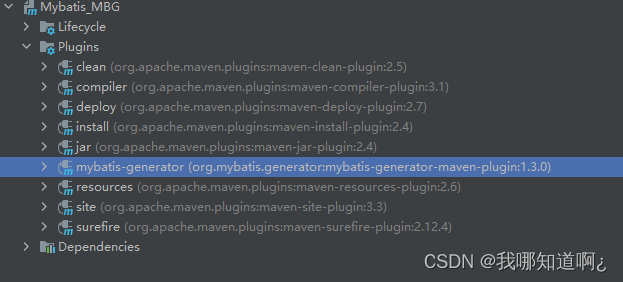
自动生成的
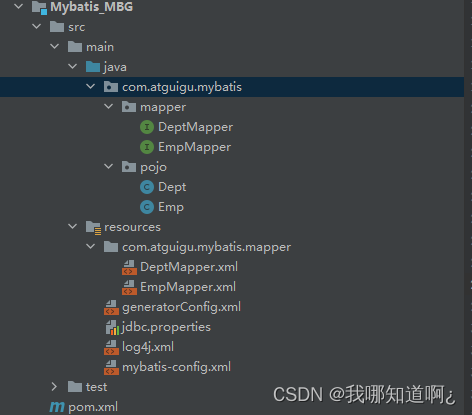
11.2mybatis逆向工程奢华尊享版
修改逆向工程配置文件中context标签中的内容为:
<context id="DB2Tables" targetRuntime="MyBatis3">
此时生成的目录
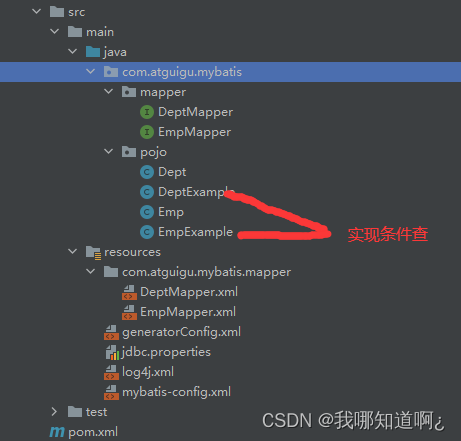
注意,映射文件中生成的带有Example的,都是带有条件的sql语句
下面是两个添加方法
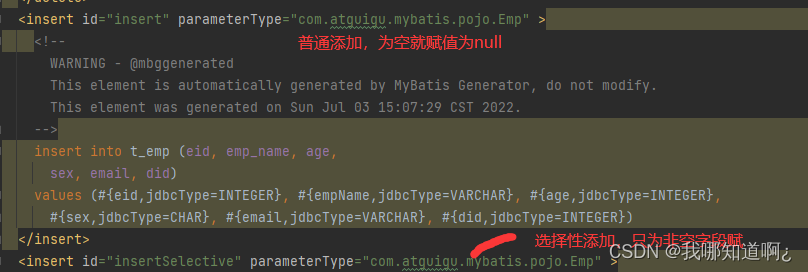
在使用中直接调用就可以了,下面是几个简单的例子,非常的方便
@org.junit.Test
public void testMBG(){
try {
InputStream is = Resources.getResourceAsStream("mybatis-config.xml");
SqlSessionFactory sqlSessionFactory = new SqlSessionFactoryBuilder().build(is);
SqlSession sqlSession = sqlSessionFactory.openSession(true);
EmpMapper mapper = sqlSession.getMapper(EmpMapper.class);
//查询所有数据,没有条件查询的就是查询所有
//List<Emp> emps = mapper.selectByExample(null);
//emps.forEach(emp -> System.out.println(emp));
//根据条件查询
EmpExample empExample = new EmpExample();
//所有的条件都是以and开头的,找到字段对应的属性名即可
/* empExample.createCriteria().andEmpNameEqualTo("张三").andAgeGreaterThanOrEqualTo(20);
empExample.or().andDidIsNull();
List<Emp> emps = mapper.selectByExample(empExample);
System.out.println(emps);*/
//根据主键修改,这样修改后,sex就会变为null
//mapper.updateByPrimaryKey(new Emp(1,"admin",22,"男","456",3));
//选择性修改,这样修改,不会修改为null的字段
mapper.updateByPrimaryKeySelective(new Emp(1,"admin",22,null,"456",3));
} catch (IOException e) {
throw new RuntimeException(e);
}
}
12.mybatis的分页插件
12.1分页插件的配置
a>添加依赖
<dependency>
<groupId>com.github.pagehelper</groupId>
<artifactId>pagehelper</artifactId>
<version>5.2.0</version>
</dependency>
b>配置分页插件
在MyBatis的核心配置文件中配置插件
<plugins>
<!--设置分页插件-->
<plugin interceptor="com.github.pagehelper.PageInterceptor"></plugin>
</plugins>
12.2分页插件的使用
分页功能,在查询语句后的limit index,pageSize
index:当前页的起始索引
pageSize:每页显示的条数
pageNum:当前页的页码
index=(pageNum-1)*pageSize
a>在查询功能之前使用PageHelper.startPage(int pageNum, int pageSize)开启分页功能
pageNum:当前页的页码
pageSize:每页显示的条数
b>在查询获取list集合之后,使用PageInfo pageInfo = new PageInfo<>(List list, intnavigatePages)获取分页相关数据
list:分页之后的数据
navigatePages:导航分页的页码数
c>分页相关数据
PageInfo{
pageNum=8, pageSize=4, size=2, startRow=29, endRow=30, total=30, pages=8,
list=Page{count=true, pageNum=8, pageSize=4, startRow=28, endRow=32, total=30,
pages=8, reasonable=false, pageSizeZero=false},
prePage=7, nextPage=0, isFirstPage=false, isLastPage=true, hasPreviousPage=true,
hasNextPage=false, navigatePages=5, navigateFirstPage4, navigateLastPage8,
navigatepageNums=[4, 5, 6, 7, 8]
}
常用数据:
pageNum:当前页的页码
pageSize:每页显示的条数
size:当前页显示的真实条数
total:总记录数
pages:总页数
prePage:上一页的页码
nextPage:下一页的页码
isFirstPage/isLastPage:是否为第一页/最后一页
hasPreviousPage/hasNextPage:是否存在上一页/下一页
navigatePages:导航分页的页码数
navigatepageNums:导航分页的页码,[1,2,3,4,5]






















 3599
3599











 被折叠的 条评论
为什么被折叠?
被折叠的 条评论
为什么被折叠?








